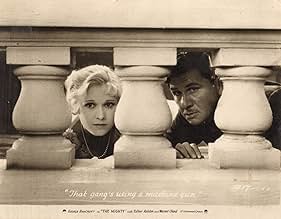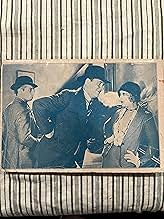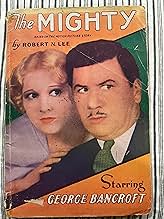Ajouter une intrigue dans votre langueA gangster's henchman becomes a hero after he is drafted to serve in the Great War.A gangster's henchman becomes a hero after he is drafted to serve in the Great War.A gangster's henchman becomes a hero after he is drafted to serve in the Great War.
Ernie Adams
- Hood
- (uncredited)
Mischa Auer
- Hood
- (uncredited)
Allan Cavan
- Police Captain
- (uncredited)
Edgar Dearing
- Doughboy
- (uncredited)
Jack Pennick
- Doughboy
- (uncredited)
Philip Sleeman
- Hood
- (uncredited)
Avis en vedette
In this tale of crooks, war and regeneration are all the elements that would sustain feature films for decades.
On the technical side, we have the Movietone (optical) soundtrack. The director uses it to great effect in a variety of ways. An early fight scene has a participant fall on a bar's roll player and ragtime music springs forth to lighten the fight's mood. Soldiers sing and one lyric strikes a nerve with a face behind a window. At a crossroad in the protagonist's life, a speech is heard through as open door. And at the film's climax, the hero and villain are trapped in a darkened room; their voices and struggling carrying the story. [Some flaws not the director's fault: wow and flutter in reel four, some scenes aren't recorded properly and Ms. Ralston's volume tails off near the end of her lines] The sound is full-bodied throughout the action scenes. Cromwell keeps the camera moving, with many shots so quick they didn't need synched.
Battle scenes are well staged and a TRAVELING crane is used extensively. A charge up a hill is made memorable by this technique. Backgrounds are realistic, especially on the train sequence. They are in-focus and fit the story's progression. The battle contains one process shot done in close-up. It's quick and it works. Gunfire is shown from behind the shooter. I had the distinct impression that "Sergeant York" borrows from two scenes done better here. The onscreen action is equaled by the ferocious tracking camera. This was well planned, as Mr. Cromwell was once quoted as telling a producer, "for every day of full rehearsal you give me, I'll knock off a day on the shooting schedule." On a Cromwell set, full rehearsal meant "with camera".
While the plot's WW I gangster-turns-war-hero story would soon become cliche, good performances and writing keep this fresh. Bancroft scored big at the box office for Paramount as the "big swell" type gangster in "Underworld" (1927), "The Dragnet" (1928) and as "Thunderbolt" (1929). He's even more at ease, here, deflecting hero praise with lines like "gunmen are what they need over here." Esther Ralston is beautiful and she performs well. Raymond Hatton is agreeably over-animated as (and I love this name) "Dogey" Franks. Warner Oland as another heavy and Dorothy Revier is his "moll". Both are fine and Ms. Revier manages to wear the entire Paramount costume department in the course of this film (just kidding, maybe half). Though it may bog briefly in a couple of spots, no talkie from 1929 even comes close to this level of action. Highly recommended.
On the technical side, we have the Movietone (optical) soundtrack. The director uses it to great effect in a variety of ways. An early fight scene has a participant fall on a bar's roll player and ragtime music springs forth to lighten the fight's mood. Soldiers sing and one lyric strikes a nerve with a face behind a window. At a crossroad in the protagonist's life, a speech is heard through as open door. And at the film's climax, the hero and villain are trapped in a darkened room; their voices and struggling carrying the story. [Some flaws not the director's fault: wow and flutter in reel four, some scenes aren't recorded properly and Ms. Ralston's volume tails off near the end of her lines] The sound is full-bodied throughout the action scenes. Cromwell keeps the camera moving, with many shots so quick they didn't need synched.
Battle scenes are well staged and a TRAVELING crane is used extensively. A charge up a hill is made memorable by this technique. Backgrounds are realistic, especially on the train sequence. They are in-focus and fit the story's progression. The battle contains one process shot done in close-up. It's quick and it works. Gunfire is shown from behind the shooter. I had the distinct impression that "Sergeant York" borrows from two scenes done better here. The onscreen action is equaled by the ferocious tracking camera. This was well planned, as Mr. Cromwell was once quoted as telling a producer, "for every day of full rehearsal you give me, I'll knock off a day on the shooting schedule." On a Cromwell set, full rehearsal meant "with camera".
While the plot's WW I gangster-turns-war-hero story would soon become cliche, good performances and writing keep this fresh. Bancroft scored big at the box office for Paramount as the "big swell" type gangster in "Underworld" (1927), "The Dragnet" (1928) and as "Thunderbolt" (1929). He's even more at ease, here, deflecting hero praise with lines like "gunmen are what they need over here." Esther Ralston is beautiful and she performs well. Raymond Hatton is agreeably over-animated as (and I love this name) "Dogey" Franks. Warner Oland as another heavy and Dorothy Revier is his "moll". Both are fine and Ms. Revier manages to wear the entire Paramount costume department in the course of this film (just kidding, maybe half). Though it may bog briefly in a couple of spots, no talkie from 1929 even comes close to this level of action. Highly recommended.
When "Trading Places" with Dan Aykroyd and Eddie Murphy came out, the premise was that if people traded places in life their choices would be different. So the poor and unfortunate Eddie Murphy was made a stock broker while the polished and affluent Dan Aykroyd was made a beggar. A similar concept was explored in "The Mighty."
Blake Greeson (George Bancroft) was a hood. He was loyal to Sterky's gang. He had no plans of doing anything different until he was drafted into the Army and made to go fight overseas. There he fought valiantly--or so it would seem.
He fought, and fought fearlessly, because he was a fearless guy. He didn't have any particular love for fighting or his country for that matter. He was just a born gunman with no fear. His platoon mate Jerry Patterson (Morgan Farley), however, loved his country and wanted to prove it in battle, except he was terrified. He had the requisite beliefs and patriotism, he was just lacking the nerve.
Jerry died in the war and Blake lived. Blake promised Jerry that he'd tell his folks how brave he was and how he died for what he believed in.
When Blake arrived in Jerry's hometown he was welcomed with a parade. He was hailed as a hero and Jerry's sister Louise (Eshter Ralston) was waiting in a car to ride alongside him. It had all the looks like she was being offered to Blake as a form of gratitude, but maybe I'm off the mark and that was what people did back then for returning soldiers--allow them to ride with a pretty girl.
Along with the parade, Blake was offered the job of chief of police. The city was plagued with menacing gangs and the city leaders felt that a strong, fearless war hero was the best person to head the police squad. Ordinarily they'd be right, but Blake still had an allegiance to his old gang. And now we get to the similarity between "The Mighty" and "Trading Places." Would Blake be different now that he was on the other side of the law and a respected individual?
Free on YouTube.
Blake Greeson (George Bancroft) was a hood. He was loyal to Sterky's gang. He had no plans of doing anything different until he was drafted into the Army and made to go fight overseas. There he fought valiantly--or so it would seem.
He fought, and fought fearlessly, because he was a fearless guy. He didn't have any particular love for fighting or his country for that matter. He was just a born gunman with no fear. His platoon mate Jerry Patterson (Morgan Farley), however, loved his country and wanted to prove it in battle, except he was terrified. He had the requisite beliefs and patriotism, he was just lacking the nerve.
Jerry died in the war and Blake lived. Blake promised Jerry that he'd tell his folks how brave he was and how he died for what he believed in.
When Blake arrived in Jerry's hometown he was welcomed with a parade. He was hailed as a hero and Jerry's sister Louise (Eshter Ralston) was waiting in a car to ride alongside him. It had all the looks like she was being offered to Blake as a form of gratitude, but maybe I'm off the mark and that was what people did back then for returning soldiers--allow them to ride with a pretty girl.
Along with the parade, Blake was offered the job of chief of police. The city was plagued with menacing gangs and the city leaders felt that a strong, fearless war hero was the best person to head the police squad. Ordinarily they'd be right, but Blake still had an allegiance to his old gang. And now we get to the similarity between "The Mighty" and "Trading Places." Would Blake be different now that he was on the other side of the law and a respected individual?
Free on YouTube.
George Bancroft is a gun man for a New York mob. When he ignores his draft notice, the MPs grab him, and the next we see of him, he's in France, slagging his lieutenant, Morgan Farley, as a coward. Farley hates Bancroft for his base mind, but admires his bravery, as Bancroft gets the Croix de Guerre and a promotion to major. Farley dies in his arms on the battlefield. After the Armistice, Bancroft goes to Farley's town to speak to his father, O. P. Heggie, and pretty sister, Esther Ralston. Impressed by Bancroft's bravery, they make him head of the local police force with a remit to clean out the gangs that have arisen. Bancroft sets to the job, but cuts a deal with his old gang leader, Warner Oland, to rob three banks at once.
It's still early days for sound at Paramount's West Coast studio, with the dialogue declamatory and buzzy, but under the direction of John Cromwell, the visuals are strikingly done under cinematographer Roy Hunt. The battle scenes, shot wild from a moving crane, are exciting and well covered by sound effects, and the post-war sequence showing Bancroft's evolution are believable.
It's still early days for sound at Paramount's West Coast studio, with the dialogue declamatory and buzzy, but under the direction of John Cromwell, the visuals are strikingly done under cinematographer Roy Hunt. The battle scenes, shot wild from a moving crane, are exciting and well covered by sound effects, and the post-war sequence showing Bancroft's evolution are believable.
Histoire
Le saviez-vous
- AnecdotesOne of over 700 Paramount productions, filmed between 1929 and 1949, which were sold to MCA/Universal in 1958 for television distribution, and have been owned and controlled by MCA ever since; its earliest documented telecasts took place in Norfolk VA Thursday 25 August 1960 on WTOL (Channel 11) and in Charlotte NC 10 September 1960 on WSOC (Channel 9).
- GaffesAlthough the story takes place in the 1917-1920 period, all of the women's hairstyles and clothes are strictly in the 1929 mode, which was quite different, especially in regards to the cloche hats and shorter skirt lengths.
Meilleurs choix
Connectez-vous pour évaluer et surveiller les recommandations personnalisées
Détails
- Durée1 heure 15 minutes
- Couleur
- Rapport de forme
- 1.20 : 1
Contribuer à cette page
Suggérer une modification ou ajouter du contenu manquant

Lacune principale
By what name was The Mighty (1929) officially released in India in English?
Répondre
































